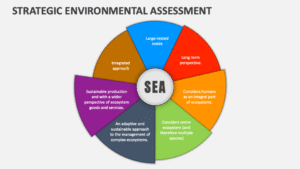Back to: Environmental Biology 400 Level
Welcome to class!
Have you ever wondered what would happen if we assessed the environmental impacts of a whole government policy or national plan before it even begins? Imagine preventing environmental damage before the first bulldozer moves—this is the power of Strategic Environmental Assessment, or SEA. Unlike the Environmental Impact Assessment (EIA), which focuses on specific projects, SEA looks at the bigger picture—policies, plans, and programmes that shape development in entire regions or sectors.
Strategic Environmental Assessment (SEA
What is Strategic Environmental Assessment (SEA)?
Strategic Environmental Assessment is a formal and systematic process used to evaluate the environmental effects of proposed policies, plans, and programmes before they are approved. It ensures that environmental and sustainability considerations are integrated into high-level decision-making, not just individual projects.

SEA is forward-looking—it guides development strategies to be environmentally sound from the start, rather than correcting mistakes after damage has been done.
Differences Between SEA and EIA
Scope: SEA applies to policies, plans, and programmes; EIA applies to specific projects.
Timing: SEA occurs early in the decision-making process; EIA comes later when a project is designed.
Influence: SEA influences broad development strategies; EIA focuses on project-level decisions.
Cumulative Effects: SEA better captures long-term, regional, or sector-wide impacts.
Steps in the SEA Process
Screening
Determine whether SEA is needed. For instance, if the government proposes a national agricultural policy, an SEA might be necessary to assess its environmental impact across multiple states.
Scoping
Identify the key environmental issues and alternatives to be considered. Public consultation often begins here.
Assessment and Reporting
Analyse environmental impacts, both positive and negative, and compare different options. A report is prepared showing findings and recommendations.
Consultation
Engage the public, stakeholders, and environmental authorities. Their input helps shape the final policy or plan.

Decision-Making
Decision-makers review the SEA findings and incorporate them into the final approval or redesign of the policy or programme.
Monitoring and Follow-Up
Track the environmental effects of the implemented plan and adapt it if necessary.
Importance of SEA in Nigeria
Promotes sustainable development across sectors like energy, agriculture, and transport
Helps avoid costly environmental mistakes
Encourages inter-agency coordination and transparency
Supports climate change resilience by building sustainability into national planning.

Example: Nigerian National Bioenergy Policy
Before launching the National Bioenergy Policy, a strategic environmental assessment was conducted. It helped identify potential impacts on food security and land use, ensuring that energy crops would not compete with food crops or harm local ecosystems.
Summary
- SEA assesses the environmental impact of policies, plans, and programmes at a strategic level.
- It differs from EIA by focusing on broad, long-term decisions rather than specific projects.
- SEA involves steps like screening, scoping, assessment, consultation, and monitoring.
- It supports sustainable development and climate-conscious decision-making.
- The Nigerian National Bioenergy Policy used SEA to prevent negative impacts on food and land.
Evaluation
- What is Strategic Environmental Assessment, and how does it differ from EIA?
- List three key steps in the SEA process.
- Why is SEA important in the Nigerian context?
- Mention one Nigerian example where SEA was applied.
- How does SEA promote sustainability in national planning?
Fantastic progress, future environmental leader! By understanding SEA, you’re gaining the vision to shape Nigeria’s future with wisdom and care. Keep learning, keep growing—Afrilearn is always proud to walk this journey with you.
